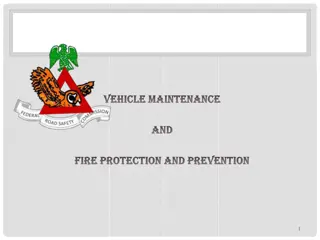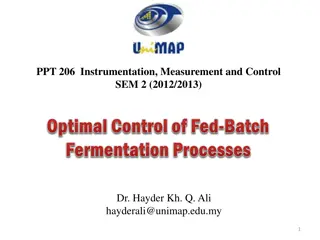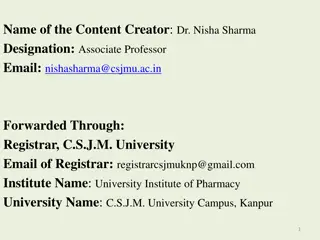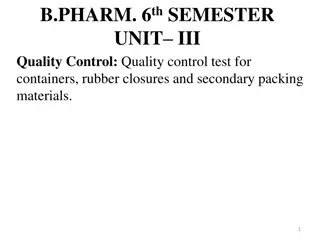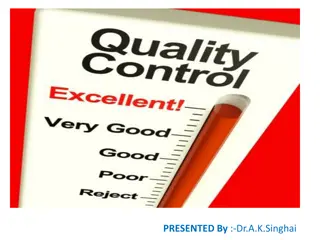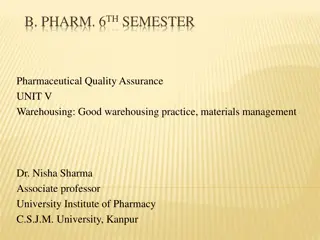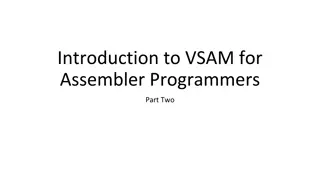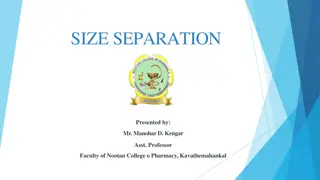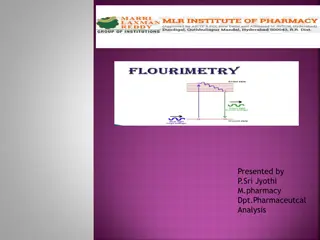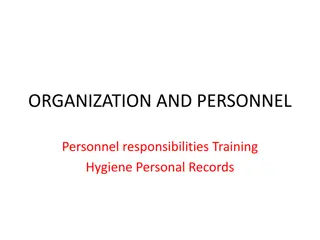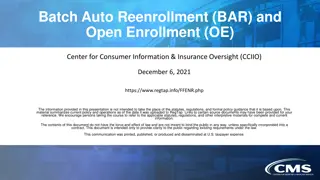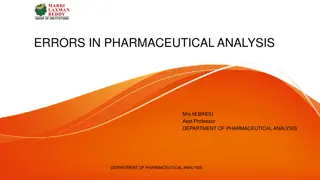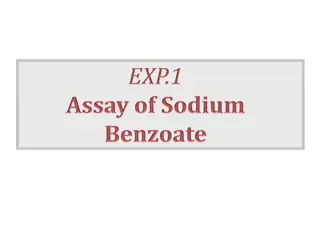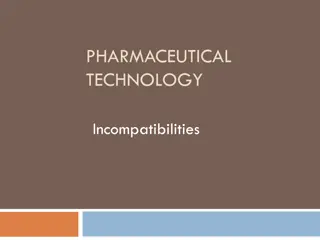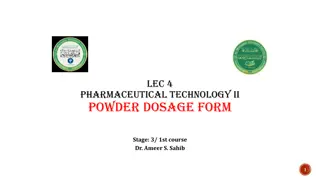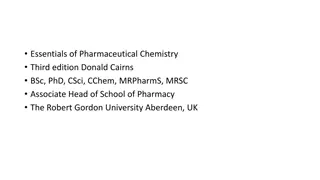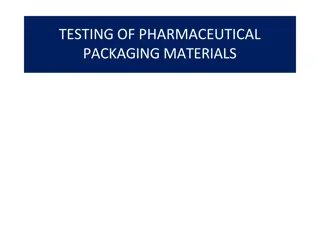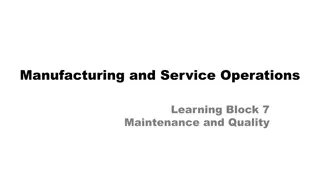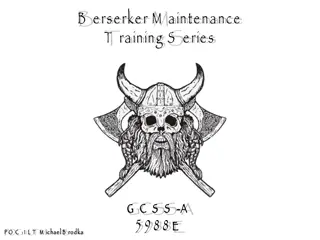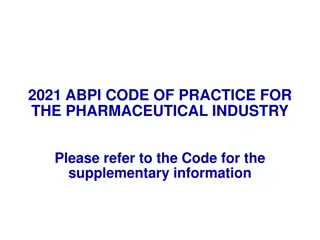Batch Record Maintenance in Pharmaceutical Industry: Essential Guidelines and Requirements
Detailed documentation is crucial in the pharmaceutical industry to ensure the quality and consistency of each batch of products. Batch records, consisting of batch processing and packaging records, contain vital information such as product details, processing stages, personnel responsibilities, equipment checks, in-process controls, yield measurements, and deviations from manufacturing instructions. Proper maintenance of batch records is essential to verify the quality of each batch and comply with regulatory standards.
Download Presentation

Please find below an Image/Link to download the presentation.
The content on the website is provided AS IS for your information and personal use only. It may not be sold, licensed, or shared on other websites without obtaining consent from the author. Download presentation by click this link. If you encounter any issues during the download, it is possible that the publisher has removed the file from their server.
E N D
Presentation Transcript
Pharm. Quality Assurance Unit IV B.PHARM 6thSEM Document maintenance in Pharmaceutical Industry: Batch Formula record, Master formula record, SOP, Quality audit, Quality review & Quality documentation, reports & documents , distribution records BY DR NISHASHARMA Dr. Nisha Sharma
Batch Record What is Batch ? A specific quantity of a drug or other material that is intended to have uniform character and quality, within specified limits, and is produced according to a single manufacturing order during the same cycle of manufacture It is a written document of the batch, prepared during pharmaceutical manufacturing process. It contains actual data and step by step process for manufacturing each batch. It is a proof that batches were properly made and checked by quality control personnel should be prepared for each intermediate and API/formulation and should include complete information relating to the production and control of each batch. Should have unique batch or identification number and dated and signed when issued Batch number should be immediately recorded in a logbook or by electronic data processing system. The record should include date of allocation, product identity, and size of batch. Dr. Nisha Sharma
Batch Record Two type: Batch Processing Records & Batch Packaging Records Batch Processing Records: Its maintained for each batch It should be based on approved Manufacturing formula & Processing instructions Design of batch processing records should be such that it should avoid any transcription errors Record must carry batch number of processed lot Before any processing begins, there should be recorded checks that the equipment and work station are clear of previous products, documents or materials not required for the planned process, and that equipment is clean and suitable for use. Dr. Nisha Sharma
BATCH PROCESSING RECORD INCLUDES During processing, the following information should be recorded at the time each action is taken and, after completion, the record should be dated and signed in agreement by the person responsible for the processing operations: a) Name of the product b) Dates and times of commencement, of significant intermediate stages and of completion of production c) Name of the person responsible for each stage of production d) Initials of the operator of different significant steps of production and, where appropriate, of the person who checked each of these operations (e.g. weighing); e) The batch number and/or analytical control number as well as the quantities of each starting material actually weighed (including the batch number and amount of any recovered or reprocessed material added); f) Any relevant processing operation or event and major equipment used; g) A record of the in-process controls and the initials of the person(s) carrying them out, and the results obtained; h) The amount of product yield obtained at different and pertinent stages of manufacture; i) Notes on special problems including details, with signed authorization for any deviation from the Manufacturing Formula and Processing Instructions. Dr. Nisha Sharma
BATCH PACKAGING RECORDS Be kept for each batch or part batch processed. It should be based on the relevant parts of the Packaging Instructions and the method of preparation of such records should be designed to avoid transcription errors. The record should carry the batch number and the quantity of bulk product to be packed, as well as the batch number and the planned quantity of finished product that will be obtained. Before any packaging operation begins, there should be recorded checks that the equipment and work station are clear of previous products, documents or materials not required for the planned packaging operations, and that equipment is clean and suitable for use. Dr. Nisha Sharma
BATCH PACKAGING RECORDS The following information should be entered at the time each action is taken and, after completion, the record should be dated and signed in agreement by the person(s) responsible for the packaging operations: a) The name of the product; b) The date(s) and times of the packaging operations; c) The name of the responsible person carrying out the packaging operation; d) The initials of the operators of the different significant steps; e) Records of checks for identity and conformity with the Packaging Instructions including the results of in-process controls; f) Details of the packaging operations carried out, including references to equipment and the packaging lines used; Dr. Nisha Sharma
BATCH PACKAGING RECORDS g) Whenever possible, samples of printed packaging materials used, including specimens of the batch coding, expiry dating and any additional overprinting; h) Notes on any special problems or unusual events including details with signed authorization for any deviation from the Manufacturing Formula and Processing Instructions; i) The quantities and reference number or identification of all printed packaging materials and bulk product issued, used, destroyed or returned to stock and the quantities of obtained product, in order to provide for an adequate reconciliation. (M.H.R.A., PIC/S GMP Guide) Dr. Nisha Sharma
BATCH MANUFACTURING RECORD is a product and batch specific document designed to give a complete and reliable picture of the manufacturing history of each batch of every product. shall be essentially based on the master formula record and shall be compiled, checked, approved and authorized by competent technical person responsible for production and quality control. Name of the product Batch number Date of commencement & completion of significant intermediate stage Name of the person responsible for each stage of production Initials of operators who carried out significant processes and initial of persons who checked, wherever applicable Dr. Nisha Sharma
BATCH MANUFACTURING RECORD Quantity, batch number, quality control report number of each ingredient actually weighed and amount of any recovered material added In-process controls carried out their results and signature of person who performed Theoretical yield & actual yield at appropriate stage of production together with explanation, if variation beyond expectation observed Authorization of any deviation, if made. Examples of Batch manufacturing records: BMR For Tablets: Mixing, Drying, etc. Dr. Nisha Sharma
Batch Formula record INCLUDES Dates , times Identity of major equipment used (e.g., reactors, driers, mills, etc.) Specific identification of each batch :weights, measures, batch numbers of raw materials, intermediates, or any reprocessed materials used during manufacturing Actual results recorded for critical process parameters Any sampling performed Signatures of the persons performing & supervising / checking critical steps of operation In-process and laboratory test results Actual yield at specific stages Description of packaging and label Representative label (commercial supply) Any deviation noted, its evaluation, & investigation conducted Results of release testing All analytical records relating to the batch, or a reference that will permit their retrieval A decision for the release or rejection of the batch, with the date and signature of the person responsible for the decision The production record review Dr. Nisha Sharma
MASTER FORMULA RECORD Master formula record is a product specific document compiled, checked, authorized and approved by competent technical personnel from different but interlinked functions such as development, production, packaging and QC as necessary and appropriate. Master formula record shall be open for review, Changes, if any to be approved by designated persons of production and QC Master formula record shall a. Give patent/proprietary name of the product, and its strength. b. Give pharmacopoeial/generic name of the product, and its strength. c. Give dosage form (e.g. tablet, ampoule) and physical characteristics of the product. d. Give sufficient, detailed information of product pack and primary packaging materials. e. Give identity, quality and quantity of every ingredient, including overages/assay value based quantities, if any, irrespective of whether, or not, the material. Dr. Nisha Sharma Next
MASTER FORMULA RECORD i) is an active drug substance in the formulation/product, ii) is used as a pharmaceutical aid (excipient). iii) appears, or is detected/tested in the final product. f. Briefly describe all the raw materials g. Give broad outlines of the process of manufacture (as a flow- chart, for example). h. Give brief description of equipment/ machinery used for manufacturing the product. i. Give step-wise manufacturing process. j. Give theoretical and practical (expected) yields at different stages of manufacture. k. Bring out in sufficient details precautions to be taken during manufacturing to ensure birth product quality and personnel safety. l. Give all analytical controls, including limits thereof, applicable to the finished product. Dr. Nisha Sharma
MASTER FORMULA RECORD m. Give stability test results covering the assigned shelf life.. n. Have a product history data giving references in manufacturing/packaging introduced over the year. o. (Preferably) contain samples of printed packaging components. Dr. Nisha Sharma
STANDARD OPERATING PROCEDURES SOP SOP is written document or instruction detailing all steps and activities of a process or procedure. These should be carried out without any deviation or modification to guarantee the expected outcome. Any modification or deviation from a given SOP should be thoroughly investigated and outcomes of the investigation documented according the internal deviation procedure. Quality impacting processes and procedures should be as per Standard Operating Procedures (SOPs). LOOK FOR VARIOUS SOP FORMATS AVAILABLE AT GOOGLE Dr. Nisha Sharma
BENEFITS OF SOP 1. To provide people with all the safety, health, environmental and operational information necessary to perform a job properly. Placing value only on production while ignoring safety, health and environment is costly in the long run. It is better to train employees in all aspects of doing a job than to face accidents, fines and litigation later. 2. To ensure that production operations are performed consistently to maintain quality control of processes and products. Consumers, from individuals to companies, want products of consistent quality and specifications. SOPs specify job steps that help standardize products and therefore quality. 3. To ensure that processes continue uninterrupted and are completed on a prescribed schedule. By following SOPs, you help ensure against process shut- downs caused by equipment failure or other facility damage. 4. To ensure that no failures occur in manufacturing and other processes that would harm anyone in the surrounding community. Following health and environmental steps in SOPs ensures against spills and emissions that threaten plant neighbors and create community outrage. Dr. Nisha Sharma
BENEFITS OF SOP 5. To ensure that approved procedures are followed in compliance with company and government regulations. Well-written SOPs help ensure that government regulations are satisfied. They also demonstrate a company's good-faith intention to operate properly. Failure to write and use good SOPs only signals government regulators that your company is not serious about compliance. 6. To serve as a training document for teaching users about the process for which the SOP was written.Thorough SOPs can be used as the basis for providing standardized training for employees who are new to a particular job and for those who need re-training. 7. To serve as a checklist for co-workers who observe job performance to reinforce proper performance. The process of actively caring about fellow workers involves one worker coaching another in all aspects of proper job performance. When the proper procedures are outlined in a good SOP, any co-worker can coach another to help improve work skills. Dr. Nisha Sharma
BENEFITS OF SOP 8. To serve as a checklist for auditors.Auditing job performance is a process similar to observation mentioned in the previous item only it usually involves record keeping. SOPs should serve as a strong basis when detailed audit checklists are developed. 9. To serve as an historical record of the how, why and when of steps in an existing process so there is a factual basis for revising those steps when a process or equipment are changed.As people move from job to job within and between companies, unwritten knowledge and skills disappear from the workplace. Properly maintained written SOPs can chronicle the best knowledge that can serve new workers when older ones move on. 10. To serve as an explanation of steps in a process so they can be reviewed in accident investigations. Although accidents are unfortunate, view them as opportunities to learn how to improve conditions. A good SOP gives you a basis from which to being investigating accidents. Dr. Nisha Sharma
Guidelines to prepare SOP Some guidelines are given below to prepare SOPS. (i) Give a clear & descriptive title to each SOP. (ii) Provide sufficient details. The SOP should meet the need of an individual, all the same, it should be general enough for more than one user. (iii) Flexibility should be written in the SOP wherever appropriate but it should not be made too general for, it may be useless in meeting its intended purpose (iv) Organize SOPs according to order of sequence of events involved in performing the operation. Write the text in straight forward and easy to follow manner. (v) After drafting SOP, use it in performing the operation to ensure that it has sufficient details to perform the operation in intended manner. (vi) Take into account the instructions from the manufacturer of the equipment which is employed in performing the operation while drafting SOP. (vii) Indicate total number of pages so that user is certain that he is performing the complete operation. (viii) Indicate the effective date of the SOP. Dr. Nisha Sharma
Quality audit Auditing : Defined as inspection of a process or a system to make sure that it complies with the requirements of its intended use. Quality Audit is key element of ISO quality system i.e. ISO 9001 pharmaceutical industry: Audits are systematic, independent examination of a Manufacturer s quality system performed at definite intervals & sufficient frequency. Aims of Audit: To check that quality system activities and results comply with Quality system procedures. Effective implementation of procedures Whether procedures are suitable to obtain quality system objective If there are any deviations corrective measures can be taken to bring the activities to normal Dr. Nisha Sharma
Quality audit Aims of Audit: Assess company s performance based on facts Obtain unbiased information on company s activities To know facts, whether company is at risk? Evaluate Manufacturer complaince with GMP Identify deficiencies & faults, improve quality Investigate root cause of quality related problems Help Mgt. reducing cost Educate & train people within organization Control external activities like supplies by vendors, & outsorced activities To make aware the suppliers about any quality related problems Dr. Nisha Sharma
TYPES Quality audit: Internal Audit (Self Inspection): Conducted within the premises to monitor the implementation and respect of GMP. This is also done to have prior information about the flaws in the system and taking necessary corrective and preventive measures. Observations of internal team must be well documented Written instructions by company for internal audit, questionnaire 1. Personnel 2. Premises including personnel facilities 3. Maintenance of buildings & equipments 4. Storage of starting materials & finished products 5. Equipment 6. Production & in process controls 7. Q.C. 8. Documentation 10. Validation & revalidation programmes 11. Recall procedure 9. Sanitation & HYGIENE Dr. Nisha Sharma
INTERNAL Quality audit 12. Calibration of instruments 14. Labeling control 15. Results of previous self inspections & corrective measures taken STEPS OF INTERNAL QUALITY AUDIT 1. Constitution of Internal audit team: Team members from out side or inside the company constituted by Mgt. , Expert should be experienced, familiar of GLP concept 2. Frequency of Audit: At least once a year, stated in procedure 3. Audit Report: At completion of process, report of results, evaluation, conclusions of inspection along with the corrective measures 4. Follow up action: Company should evaluate internal audit & recommend corrective measures to be followed timely for effective results Dr. Nisha Sharma 13. Complaints Mgt
EXTERNAL Quality audit External Audit: Conducted for the suppliers or any outsourcing operations carried out by the pharmaceutical industry. The contract giver (Industry) is responsible to access the competence of the Contract acceptor (supplier or any other outsource operations department) as per the GMP guidelines. Done to evaluate the ability of suppliers (raw material, packaging materials etc.) to conform GLP std. Pharmaceutical company may conduct audits of their suppliers External audits STEPS 1. Notification: To alert the company, Date & time of audit. List of documents auditors wants to review can be provided 2. Planning: The auditor identify key areas of risk & areas of concern to be evaluated during audit 3. Opening Meeting: Meeting b/w auditors & staff of company under audit. Process of audit is described. Company under audit explains auditors about schedule of employees, areas of concern of audit Dr. Nisha Sharma
EXTERNAL Quality audit STEPS 4. Start of Audit procedure: After opening meeting, final audit plan is prepared. Company employees are notified of audit sch. & procedure starts 5. Communication: Audit team should be in touch with company s audit team for clarifications on procedures, for access to company docs. 6. Draft audit report: After completion of audit, draft report is prepared. It contains outcomes of audit, list of concerns. Then submitted to company Mgt. for review & suggestions if any 7. Mgt response: Final audit report is prepared and submitted to company Mgt. The Mgt is requested for there agree/ disagree with report, any corrective measures, problems etc. & expected date of addressal of problems or compliance. Dr. Nisha Sharma
EXTERNAL Quality audit STEPS 8. Final Meeting: Between auditors & company officials/ Mgt. to close loose ends, discuss Mgt. response & sccope of audit 9. Report distribution: Distribution of final audit report to concerned officials inside & outside audit area 10. Feedback: Audited company implements recommended changes & auditors review, test quality, adherence effects of implemented changes. Dr. Nisha Sharma
Quality audit It is mandatory that there should be a well written procedure for conducting an audit whether it is an internal or external audit. Important points in Quality Audit Frequency of Audit: The procedure how frequency of audit must be defined and as per that frequency must be set and followed accordingly. Responsibilities: The audit team must be defined that who will be responsible for conducting and reviewing the audit reports. The people in the audit team must be well equipped with the operations and procedures that are being audited. Documentation: It is important to document each and every audit conducted as it not only helps from regulatory perspective but also act as reference document to have a insight of flaws previously faced. Dr. Nisha Sharma
Quality audit CONDUCTING AUDIT: The audit team must abide rules and regulations specific to the operations carried out at the premises. Ex: if the audit is conducted in aseptic section it is mandatory to put the safety clothing as per cGMP that is must for everyone who so ever enter that portion. The audit must be done by communicating by the audit team with the personnel working and all the findings must be documented. But it is also important to explain the observations that make it more realistic rather than just noting it down and explaining later on. The audit team must be flexible. The procedure to meet the requirements of cGMP could be different in different industries hence the auditor must focus on the results and then decide about the observations. The conclusions obtained must be prepared, documented and finally completed as a audit report. Dr. Nisha Sharma
Quality review & Quality documentation Quality Review is the last stage in QC procedure, before the dispatch of product It ensures that the finished product released for sale, all the relevant records (production and control records) are cross checked i.e. reviewed. Thorough investigation of any batch not conforming to standards Other batches of same product with specific failure needs to be investigated Written record of investigation, conclusion of investigation, follow up (remedial measures) must be kept Objective of Product Quality Review: To evaluate compliance status of manufacture & identify areas of improvements It should involve personnel from QC unit, production, engineering, maintenance, Purchase etc. Dr. Nisha Sharma
Quality review & Quality documentation Review of following should be done periodically & documented: Starting materials/ packaging material used, sources, supply chain Critical in process controls & finished product test Failed batches with results of investigation Significant deviations, investigations, preventive measures taken Changes done in process & analytical methods Sales authorization submitted, granted, rejected for third party (Exports) dossiers Stability monitoring results, adverse trends All quality related returns, complaints, recalls, investigation made Previous product, process or equipment corrective measures Post marketing commitments, new marketing authorizations etc Qualifying status of equipments, utilities used: HVAC Dr. Nisha Sharma
QUALITY DOCUMENT (GDP Good document practices) Document is any written statement or proof of any activity in pharmaceuticals. Documentations are to define the manufacturers system of information & control, to minimize the risk of misinterpretation & errors inherent in oral or casually written communication, to provide unambiguous procedures to be followed to provide confirmation of performance, to allow calculations to be checked & to allow tracing of batch history Good documentation is a systematic procedure of preparation, checking, verifying, issuing, storing and reviewing of any documents. prevent errors of various activities in pharma Purpose of Documentations Defines specifications and procedures for all materials and methods of manufacture and control Ensures all personnel know what to do and when to do it Ensure that authorized persons have all information necessary for release of product Ensures documented evidence, traceability, provide records and audit trail for investigation Ensures availability of data for validation, review and statistical analysis. Dr. Nisha Sharma
QUALITY DOCUMENT (GDP Good document practices) Classification of Documentation organization & Personnel. For Buildings & facilities For Equipments. For Handling of R.M.& P.M. For Production & process control. For Packaging & Labeling control. For Holding & Distribution For Laboratory Control. For Records & Reports. For Return & Salvaged finished products. Dr. Nisha Sharma
QUALITY DOCUMENT (GDP Good document practices) Preparation, issues and uses of Documents Documents should be carefully and logically specify to prevent wrong uses. All necessary information s are written unambiguously. Each document includes: 1. Company name 2. Purpose and title of documents 3. Identification No and revision No. 4. Date of authorization 5. Date of review 6. Signature of prepared by, checked and authorized by. 7. Distribution list 8. Page no. 9. Reason for revision should be documented. 10. Abbreviation and reference Dr. Nisha Sharma
QUALITY DOCUMENT (GDP Good document practices) Preparation, issues and uses of Documents Documents should be carefully and logically specify to prevent wrong uses. All necessary information s are written unambiguously. Each document includes: 1. Company name 2. Purpose and title of documents 3. Identification No and revision No. 4. Date of authorization 5. Date of review 6. Signature of prepared by, checked and authorized by. 7. Distribution list 8. Page no. 9. Reason for revision should be documented. 10. Abbreviation and reference Dr. Nisha Sharma
HEIRARCHY OF QUALITY DOCUMENTATION SYSTEM Outlines company s Goal, mission, vision Quality Manual Define the quality objectives POLICY Describes what should be done, by whom,, how, when, where PROCEDURE Working instruction Description of activities Records Quality documentation system Dr. Nisha Sharma
QUALITY MANUAL It is guiding document, approved by upper management, outlines companies goals, vision and mission, Describes the scope of QMS: what to be included in Quality system Explains each & every requirement of ISO 9001 It should include: Title & table of contents Scope of QMS Exclusions from ISO 9001 Version information & approval Quality policy & objectives QMS description Business process model of organization Definition of responsibilities for all personnel for all personnels References to relevant documents Relevant appendices Dr. Nisha Sharma
QUALITY MANUAL Purpose of QUALITY MANUAL: Communicate mgt s expectations for quality to the organization Organizations conformity with ISO 9001 requirements Measure for compliance to Mgt s expectations for Internal audits: ISO Registrar audits, customer audits QUALITY POLICY: It is declaration by the organization It defines the quality objectives to which the organization strives. Should provide outline for creating, stating, measuring the performance of quality objectives Ex: To provide products & services meeting the expectations of customers. Actively pursue ever improving quality by various programs so to enable the employees to do the wok correctly for the first time and ever Dr. Nisha Sharma
QUALITY MANUAL QUALITY PROCEDURES: Can be described by text, tables, flowcharts to make them effective Elements of quality procedures: 1. Title: Identifies procedure 2. Purpose: Explain why this procedure 3. Scope: what expects will be covered in procedure & what will not 4. Responsibilities of all persons, functions to be the part 5. Records as a result of activities done as per procedure 6. Document control: Identification of changes, date of review, approval & version of document should be included in procedure 7. Description of activities: This relates all other elements of procedures, describes what to be done, by whom, how, when & where. Its most imp. Inputs & outputs of activities must be explained 8. Appendices to be included if required Dr. Nisha Sharma
QUALITY MANUAL Work Instructions: covers following 1. Manner in which work will be done 2. Equipment & tools that will be used 3. Environment or location associated with the work 4. Material handling requirements 5. Safety alerts for all employees 6. Cross reference to any other required process or instructions 7. Critical process & Product parameters to be monitored including instructions of monitoring 8. Equipment maintenance procedures 9. Methods for verifying that product meets specs 10. Other non product related criteria for the final product Dr. Nisha Sharma
QUALITY MANUAL RECORDS: It is final tier of Quality Documentation system. All data, information's, records, forms etc are achieved. Quality records management shows that quality system has been executed. It describes how the quality of end product was verified to meet the specs, meeting the customers satisfaction and needs. SOURCES QUALITY RECORDS Non conformance investigations CAPA s (Corrective & preventive action) AUDIT RESULTS SUPPLIER DOCUMENTATION CALIBRATION RESULTS MAINTENANCE RECORDS Dr. Nisha Sharma
QUALITY MANUAL RECORDS: It is final tier of Quality Documentation system. All data, information's, records, forms etc are achieved. Quality records management shows that quality system has been executed. It describes how the quality of end product was verified to meet the specs, meeting the customers satisfaction and needs. SOURCES QUALITY RECORDS Non conformance investigations CAPA s (Corrective & preventive action) AUDIT RESULTS SUPPLIER DOCUMENTATION CALIBRATION RESULTS MAINTENANCE RECORDS Dr. Nisha Sharma
Model of document D- Design, development, dossiers, drug master file for regulated markets, distribution records O- Operational procedures, techniques, methods, out of specs. (OOS), Out of trend (OOT) C- Cleaning, calibration, controls, complaints, containers, closures, contamination, change control U- User requirement specs, utilities likewater systems, HVAC, AHU (air handling unit) etc M- Man, materials, machines, methods, maintenance, mfg, mfg operations & control, monitoring, Master formula, manuals (quality, safety, environment), medical records E- Engg. Control & practices, Envion. Control, equipment qualification, documents, N- Non routine activities, New products & substances T- Technology transfer, training, testing, trend analysis, technical dossiers S- SOP, safety practices, sanitation, storage, self inspection, standardization, supplier qualification, specification & standard test procedures & site master file Dr. Nisha Sharma
Reports & documents They are used through out manufacturing process, and in supporting process (QA/QC). It must meet Good Documentation Process. Various records/ reports are (some) Batch Record Form * Bill of materials Specifications * Policies Protocols * SOP s Work instructions * Checklist Forms/ Log sheets * Certificate of analysis Technical transfer reports * Technical agreements Technical reports * Test methods Training assessments * Worksheets, logbooks, etc Validation docs * Quality manual Audit plans * Manufact./ pack. Instructions Quality system docs * Deviation reports etc Dr. Nisha Sharma
DISTRIBUTION RECORDS Good distribution practices (GDP) : Proper storage & distribution of drug products minimizes risk of its quality These are written data of distribution of drug products from Mfg. to distributors Records of distribution retained, accessible to trace history if req. Helps in recall of product when in need Distribution Records contain information on wholesalers, direct costumers SOP s of warehousing & distribution of products to be adopted Periodic audit of warehouse & distribution centers Before dispatch of a batch, ensure about the testing, approval, & release by QC, Random inspection on consignments to ensure correctness of goods must be done Maintain Distribution registers having details about distribution: Name, strength, dosage form description, consignees name & address, date & quantity shipped, lot number of drug product. Maintain inventory card also to find the position of stock. Dr. Nisha Sharma
Inventory card DISTRIBUTION RECORDS FORMAT OF INVENTORY CARD M/S Name & address of company Name of Poduct Receipt No Date of issue Transfer No. Quantity Received Quantity Issued Invoice No. Batch No. Address of distributor Balance Sign of issuing person Dr. Nisha Sharma
Inventory card DISTRIBUTION RECORDS Checklist of distribution records 1. Whether pre dispatch inspections are carried out before release 2. Whether periodic audit of distribution centre are carried out to access warehousing practices 3. Whether distribution records are part of batch record. If not how batch wise distribution record up to retail levels are maintained 4. Whether instruction for warehousing & stocking of products like Low volume parentrals (LVP s), heat sensitive etc. are available in store 5. Whether Good distribution practices followed Y/N Y/N Yes/N Yes/N Y/N Dr. Nisha Sharma


